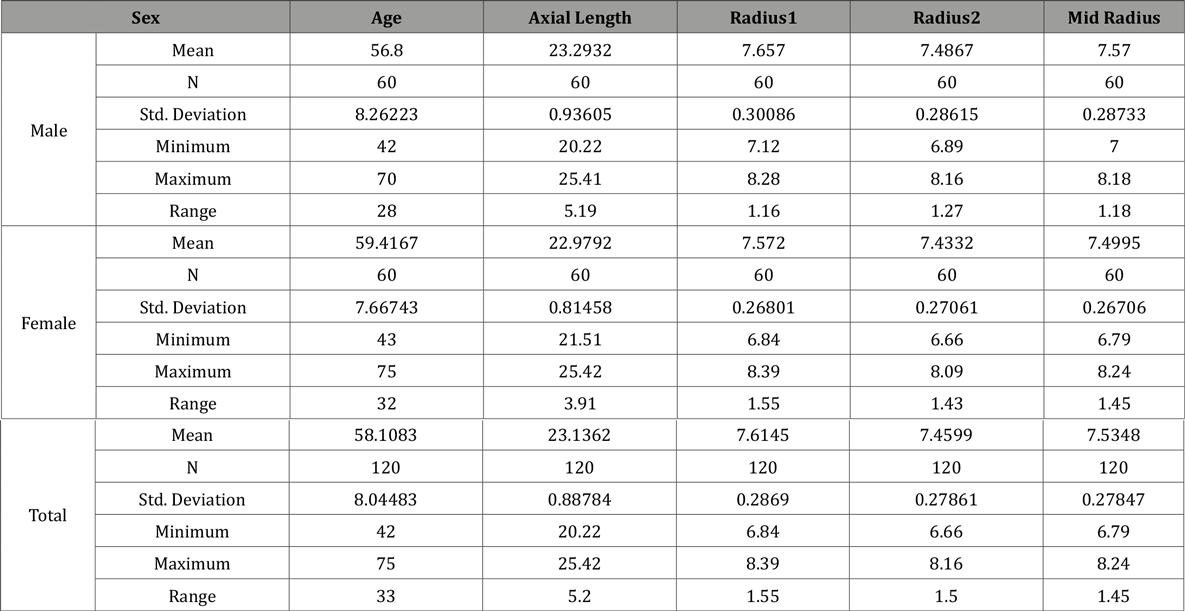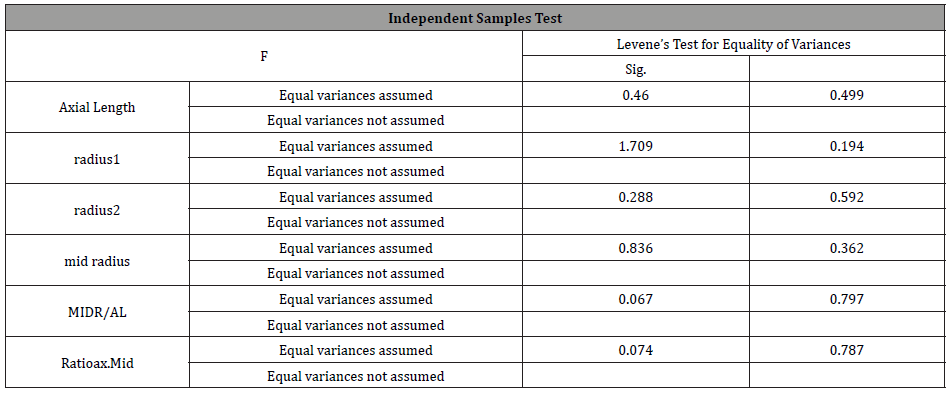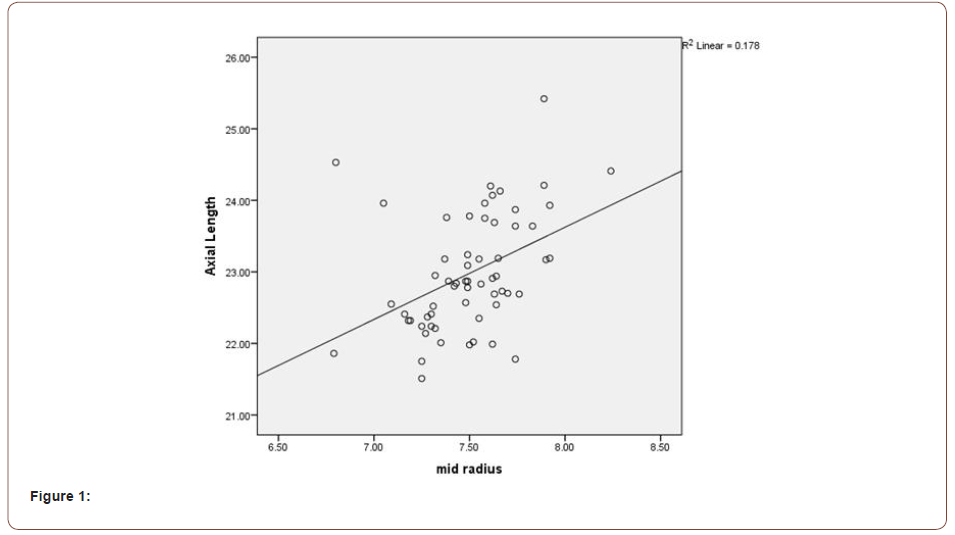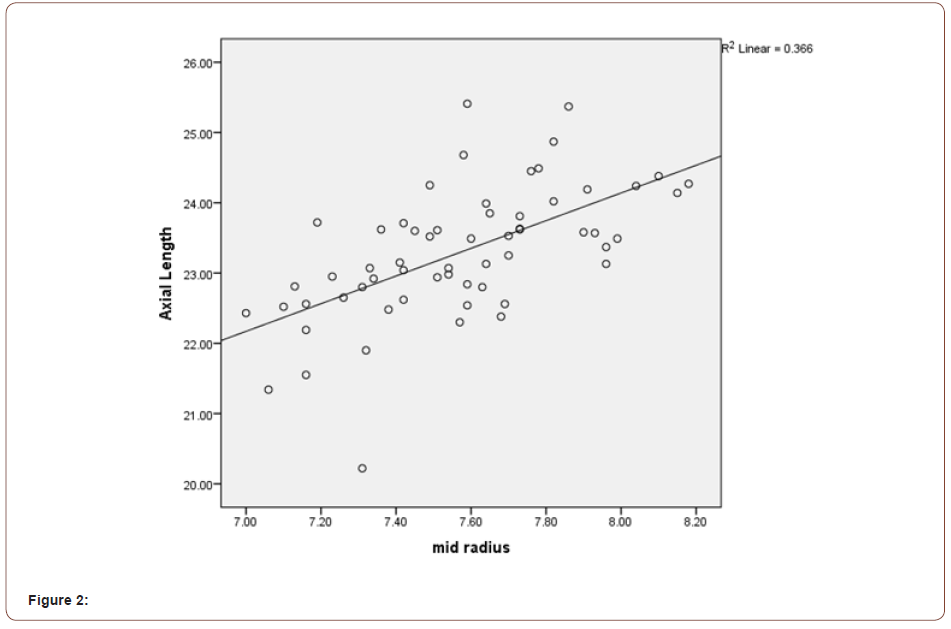 Research Article
Research Article
Relationship between Eye Axial Length and Corneal Radius of Curvature
Dr Ali Maeiyat Ivatlou1* and Mehdi Tabatabaei2
1MD.MS in Optometry, Faculty of Rehabilitation, Shahid Beheshti University of Medical Sciences, Iran
2Master’s Degree in Faculty Member, Faculty of Rehabilitation, Shahid Beheshti University of Medical Sciences, Iran
Dr Ali Maeiyat Ivatlou, MD.MS in Optometry, Faculty of Rehabilitation, Shahid Beheshti University of Medical Sciences, Iran.
Received Date: May 16, 2022; Published Date: August 30, 2022
Abstract
Introduction and goals: To study and determine the relationship between eye axial length and corneal radius of curvature, as the entire
advancements in medicine have originated from basic studies. The goal of the research is to determine average size of different parts of body and
their relationship.
Materials and methods: The research is a descriptive and analytical study. The statistics population consisted of 150,000 eyes in 150,000
patients (55% male, 45% female) who turned to Sadr Tehran Hospital during 2003 to 2013. The patients were examined by an optometrist (the
researcher). The average age of men was 56.8 years (42-70) and the average age of women was 59.4 (43-75) years old. Patients with history of eyes
surgery, glaucoma, impacts, surface eye diseases and contact lens users were excluded from the study. The anterior posterior length of eye and the
corneal curvature of both eyes were checked by Coherent biometry (IOL.MASTER) in three to four repetitions by one optometrist, the research, and
the measurements were made. The average of the measurement was then calculated. The relationship between the factors was assessed in linear
form and was then studied and compared between the two genders. The SPSS-22 software was used for analyzing the data.
Findings: The mean average corneal curvature radius in men was 7.570mm in 7.00-8.18 range and in women, this number was 7.499mm in 6.79-
8.34 range. The mean length of anterior posterior length (axial length) in men was 23.79mm in 20.22-25.41 range and in women, it was 22.97mm in
21.51-25.62 range. By testing the data, it was shown that data had normal distribution and the following linear relation was found between the two
parameters. In general state, AL=1.69 MidR+10.335, the value in women was AL=1.288MidR+13.32 and in men, it was AL=1.97MidR+0.38.
Discussion and Conclusion: By comparing the previous studies, it was showed that the axial length of Iranian population eyes, in this study,
was shorter than Americans and South Koreans, longer than Indians and almost equal to Chinese. It was shown that as the cornea is more flat, the
axial length of eye is higher; and in turn, as the axial length of eye is higher, the cornea tends to be more flat. In addition, the ratio of these changes was
slightly bigger in men than women. This finding could be effective in improving precision of medical procedures in treating cataract, Keratoconus
and refractive surgeries.
Keywords: Axial length; Corneal curvature radius; Biometry
Introduction and Goals
It is not too much a claim to say that all advancements in medical science have originated from basic studies and determining the average size of various parts of body [1]. In ophthalmology too, after Gullstrand’s schematic eye design and his presenting the approximate measures, the issue of emteropisation, refractive defects’became justifiable [2]. Today, by changes in the corneal curvature radius, keratoconus and various refractory defects could be treated with more precision; and by determining the exact size of corneal curvature radius and axial length, the power of contact lenses in cataract surgery could be discussed more elaborately [3]. The axial length of eye is a basic parameter in ophthalmology. Axial length means the distance between the corneal surface to the pigmented layer of retina and the membrane which is measured in millimeter [4]. Since cornea is responsible for 2.3 optic power of eye, formation of image on retina, in addition to its clarity and difference in its refraction factor with air, also relates to its curvature radius [5]. This factor is also measured in millimeter scale. Many studies have been conducted on this subject in various populations including England, USA, Korea, Singapore, south and central India, Alaska and other countries [6-22] and large populations in north and south China and Nigeria have been attributed to this [23- 24]. In our country too, the only study which is attributed to the research was conducted in Farabi Hospital in 1997 with only one thousand populations and only the average was calculated with no study of any relationship or lack of relationship on them [25]. Since most results of these studies were obtained in other societies and the applicable formula which are developed to be used in medical facilities, all of them have been based on this basic information. Perhaps, the reason that all facilities and medical procedures do not respond in our country one hundred percent could be due to the difference of axial length and the average corneal curvature radius, as well as their relationship in our society compared to western societies. In any case, knowing these results could be effective and suitable in future researches of local and foreign researchers in improving medical methods and better performance of new medical facilities.
Materials and Methods
The study is descriptive-analytical and seeks the finding the correlation. The population subject of study consisted of 150,000 patients that turned to the biometry clinic of Sadr Tehran Hospital during 2004-2013, all of them were examined by one person (the researcher). The amounts which were obtained were registered after 3-4 repetitions. The tools used for measuring the research parameters (axial length and corneal curvature radius) was IOL Master apparatus, Zeiss model which was used by considering partial coherence laser interferometer. Presently, this apparatus is the most precise devices in this study. After the approval of the plan by the research council of Shahid Beheshti University in Tehran, coordination was made with the head of Sadr Social Security Hospital and permit was received. By the assistance of filing unit, the medical files of all patients that referred to biometry clinic of hospital were reviewed in observational method and 150,000 files that had the criteria of entering into study (being older than 40, having letter of consent for studying the file, having Iranian nationality, absence of any corneal and retina abnormalities and systemic diseases effective in the examinations results) were selected (44.34% male, 55.66% female). As far as the research is aware no study was found in determining the relationship between the axial length of eye and corneal curvature radius, by using a 15-preliminary sample and considering β=0.1, α=0.05, the volume of sample, was calculated and the number for each group was obtained as 60. After determining the volume of 60 samples, for each group, first the files were divided into two groups as per the sex and were labeled. Then the probable and systematic method was used for sampling and 60 files were selected from each group; and the research parameters were registered for each patient from their files. The information obtained was registered in two groups and the average of parameters in statistical subjects was calculated once in general and the other term separately as per the gender to find their ratio. By using Semenov- Kolomogrov method, the normality of the data was studied, followed by studying the t-test and linear regression between the data by using SPSS22 software.
Findings
Among 150,000 eyes which were examined, and after determining the 60 samples volumes for both male and female group, following results and average was found (Table 1). After determining the average of all parameters, especially AL and CRC, the Semenov- Kolomogrov tests showed the normality of data distribution. In addition, by performing levene test the equivalency of the variance of the two independent samples of men and women was proved (P-value<0.05=α) (Table 2).
Table 1:

Table 2:

After proving the equality of variances, the t-test was performed with α=0.05 and 118 freedom degree and with respect to the results and data, the significance was proved which showed that practically, gender had no effect on any of the variables. The correlation between AL and CRL variables in both men and women was proved by using Pierson’s correlation coefficient and the diagram of the frequency of both variables is visible in both groups (Figure 1,2).


The regression line slope and dispersion of pints indicated the correlation between the two variables CRC and AL in both groups. After that, by using ANOVA table, the significance of regression line with α=0.05 was confirmed. To obtain a linear relationship between the two variables, the coefficients regression table was used and following relations were found.
In general state: AL=1.288 midR+13.32
In women: AL=1.97mid R+8.383
In men: AL=1.69MidR+10.330
Axial length and corneal curvature radius are two basic parameters in optimized performance of eye. The goal of present study is to examine the relationship between the two parameters. The results of this research show that the average axial length is 23.136mm with 0.887 criteria deviation in 5.2mm range. This value in separate form was 23.2932mm in men in 0.936 criteria deviation and 5.19mm range, and in women, this value was 22.979mm with 0.814 criteria deviation and 3.91mm range. The average cornea curvature radius in this study was 7.534mm with 0.278 criteria deviation and 1.45 range. In separate form, in men, this number was 7.57mm with 0.287 criteria deviation and 1.18mm range and in women, the average corneal curvature radius was 7.499mm with 0.267 criteria deviation and 1.45mm range.
Discussion
In comparison with the previous studies [18-25], it could be observed that south Korean people with AL=24.35+1.49 had the longest axial length, followed by Americans, AL=22.04, Taipei China with AL=23.3+1.2, Chinese with AL=23.25+1.14 and Iranians with AL=23.13+2.6 were almost the same and the shortest were Indians with AL=22.6+0.91 had the smallest eyes. On corneal curvature, it was observed the the Koreans had more steep cornea than others. In studies in gender, it was seen that AL in men was bigger than women and women’s cornea is steeper than men’s cornea. In the meantime, by considering the linear formulas, it was observed that as AL is bigger, cornea is more flat and vise-versa. These changes are slightly more tangible in men than women; that is, if the corneal curvature radius is increased or decreased for only few millimeters, the effects are more visible in AL measurement in men. Since most medical procedures in refractive, Keratoconus, cataract and other refractory defects in eyes have been planned by making changes in those parameters, the results of this study could be a step, though small, in improving and increasing the precision of these medical procedures and helps other researchers in this area of science.
Conclusion
In comparing the present study with previous studies, it is shown that the axial length of Iranian’s eyes in this study was smaller than Americans and South Koreans, longer than Indians and almost the same with Chinese. As more flat the cornea, the AL will be larger and otherwise, as the AL is bigger, the cornea tends to become more flat. This fining was seen and confirmed as well. The ratio of these changes is slightly higher in men compared to women and this finding could be effective in improving the precision of cataract, keratoconus and refractive surgery precision.
Acknowledgement
The author extends its appreciation on those who assisted in this research, especially the mangers and personnel of Sadr Hospital without whose help, the research could not be done.
Conflict of Interest
No Conflict of Interest.
References
- Stenstrom S (1948) Investigation of the variation and the correlation of the optical elements of human eyes. American journal of optometry and archives of American Academy of Optometry 25(10): 496-504.
- Hirsch MJ, Weymouth FW (1947) Notes on ametropia; a further analysis of Stenstrom's data. American journal of optometry and archives of American Academy of Optometry 24(12): 601-608.
- Hitzenberger CK (1991) Optical measurement of the axial eye length by laser Doppler interferometry. Invest Ophthalmol Vis Sci 32(3): 616-624.
- Iribarren R, Morgan IG, Nangia V, Jonas JB (2012) Crystalline lens power and refractive error. Invest Ophthalmol Vis Sci 53(2): 543-550.
- Lavanya R, Kawasaki R, Tay WT, Cheung GC, Mitchell P, et al. (2010) Hyperopic refractive error and shorter axial length are associated with age-related macular degeneration: the Singapore Malay Eye Study. Investigative ophthalmology & visual science 51(12): 6247-6252.
- Wong TY, Foster PJ, Ng TP, Tielsch JM, Johnson GJ, et al. (2001) Variations in ocular biometry in an adult Chinese population in Singapore: the Tanjong Pagar Survey. Investigative Ophthalmology and Visual Science 42(1): 73-80.
- Saw SM, Carkeet A, Chia KS, Stone RA, Tan DT (2002) Component dependent risk factors for ocular parameters in Singapore Chinese children. Ophthalmology 109(11): 2065-2071.
- George R, Paul P, Baskaran M, Ramesh SV, Raju P, et al. (2003) Ocular biometry in occludable angles and angle closure glaucoma: a population based survey. British journal of ophthalmology 87(4): 399-402.
- Wojciechowski R, Congdon N, Anninger W, Broman AT (2003) Age, gender, biometry, refractive error, and the anterior chamber angle among Alaskan Eskimos. Ophthalmology 110(2): 365-375.
- Wickremasinghe S, Foster PJ, Uranchimeg D, Lee PS, Devereux JG, et al. (2004) Ocular biometry and refraction in Mongolian adults. Investigative ophthalmology & visual science 45(3): 776-783.
- Shufelt C, Fraser-Bell S, Ying-Lai M, Torres M, Varma R (2005) Refractive error, ocular biometry, and lens opalescence in an adult population: the Los Angeles Latino Eye Study. Investigative Ophthalmology and Visual Science 46(12): 4450-4460.
- Ojaimi E, Rose KA, Morgan IG, Smith W, Martin FJ, et al. (2005) Distribution of ocular biometric parameters and refraction in a population-based study of Australian children. Investigative ophthalmology & visual science 46(8): 2748-2754.
- Wu HM, Gupta A, Newland HS, Selva D, Aung T, et al. (2007) Association between stature, ocular biometry and refraction in an adult population in rural Myanmar: the Meiktila eye study. Clinical & experimental ophthalmology 35(9):834-839.
- Saw SM, Wong TY, Ting S, Foong AW, Foster PJ (2007) The relationship between anterior chamber depth and the presence of diabetes in the Tanjong Pagar Survey. American journal of ophthalmology 144(2): 325-326.
- Warrier S, Wu HM, Newland HS, Muecke J, Selva D, et al. (2008) Ocular biometry and determinants of refractive error in rural Myanmar: the Meiktila Eye Study. British Journal of Ophthalmology 92(12): 1591-1594.
- Lee KE, Klein BE, Klein R, Quandt Z, Wong TY (2009) Association of age, stature, and education with ocular dimensions in an older white population. Archives of ophthalmology 127(1): 88-93.
- Nangia V, Jonas JB, Sinha A, Matin A, Kulkarni M, et al. (2010) Ocular axial length and its associations in an adult population of central rural India: the Central India Eye and Medical Study. Ophthalmology 117(7): 1360-1366.
- Foster P, Broadway D, Hayat S, Luben R, Dalzell N, et al. (2010) Refractive error, axial length and anterior chamber depth of the eye in British adults: the EPIC-Norfolk Eye Study. British Journal of Ophthalmology 94(7): 827-830.
- Hosny M, Alio JL, Claramonte P, Attia WH, Pérez-Santonja JJ (2000) Relationship between anterior chamber depth, refractive state, corneal diameter, and axial length. Journal of Refractive Surgery 16(3): 336-340.
- Chen MJ, Liu YT, Tsai CC, Chen YC, Chou CK, et al. (2009) Relationship between central corneal thickness, refractive error, corneal curvature, anterior chamber depth and axial length. Journal of the Chinese Medical Association 72(3): 133-137.
- Park SH, Park KH, Kim JM, Choi CY (2010) Relation between axial length and ocular parameters. Ophthalmologica 224(3): 188-193.
- Merriam J, Zheng L (2005) The relationship of corneal curvature and axial length in adults. Investigative Ophthalmology & Visual Science 46(13): 864.
- Yin G, Wang YX, Zheng ZY, Yang H, Xu L, et al. (2012) Ocular axial length and its associations in Chinese: the Beijing Eye Study. PloS one 7(8): e43172.
- Iyamu E, Iyamu J, Obiakor CI (2011) The Role of Axial Length-Corneal Radius of Curvature Ratio in Refractive State Categorization in a Nigerian Population. ISRN ophthalmology 2011: 138941.
- Mirshekari A, Shakeri B (1998) Evalution of Mean of Corneal Curvature and Axial Length in Farabi Hospital. Iranian Journal of Ophthalmology 10: 3-4.
-
Dr Ali Maeiyat Ivatlou and Mehdi Tabatabaei. Relationship between Eye Axial Length and Corneal Radius of Curvature. W J Opthalmol & Vision Res. 4(2): 2022. WJOVR.MS.ID.000585. DOI: 10.33552/WJOVR.2022.04.000585.
-
IOL Master apparatus, Kolomogrov method, Optimized performance, Refractive, Keratoconus, Cataract, Refractory defects, Axial length, Semenov, Preliminary sample, Corneal curvature radius, Biometry
-

This work is licensed under a Creative Commons Attribution-NonCommercial 4.0 International License.






